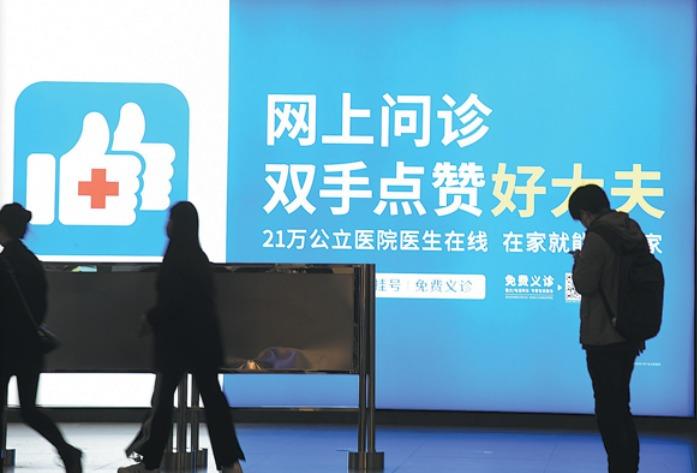 People pass an LED billboard of online healthcare firm Haodf.com in Beijing. (MAO XUQIAN / FOR CHINA DAILY)
People pass an LED billboard of online healthcare firm Haodf.com in Beijing. (MAO XUQIAN / FOR CHINA DAILY)
Enlarging services-based consumption will be one of the keys to fueling next-stage economic growth, officials and experts said on Wednesday.
China has proposed a 5 percent average annual growth rate for the total retail sales of consumer goods during its 14th Five-Year Plan period (2021-25)
Their comments reinforced the importance of a key piece of data from the Ministry of Commerce unveiled in late July-that services-related consumption accounted for 52.5 percent of China's household consumption in the first half of this year.
The COVID-19 and travel restrictions in many parts of the world have pushed a large number of Chinese consumers to spend money in the home market, and created opportunities for many businesses in the services sector.
For instance, online healthcare and online education have been booming since the second half of last year, said Xing Houyuan, director of the Beijing-based China Service Outsourcing Research Center.
"With people's living standards continuing to improve, we found that the nation's consumption trend has upgraded from purchasing goods to consumption of services, and the share of consumption of services is getting bigger," said Zhu Xiaoliang, director-general of the department of market operation and consumption promotion at the Ministry of Commerce.
ALSO READ: New income data script stronger 2nd-half consumption outlook
The consumption of services has been viewed as "process consumption", because production is part of consumption of services and is not simply considered as the outcome of a production process, as is the case with the traditional marketing of physical goods, according to information released by the ministry.
China has proposed a 5 percent average annual growth rate for the total retail sales of consumer goods during its 14th Five-Year Plan period (2021-25), according to the ministry's business growth plan for the same period released in early July.
As the total retail sales of consumer goods have shown a steady and slow development trend in recent years, services-based consumption will continue to grow, and its share of the country's household consumption will also increase in the coming years, Zhu said.
Zhang Yongjun, a researcher at the China Center for International Economic Exchanges in Beijing, said that accelerating the growth of high-quality consumption will further unleash consumption potential in the services sector, and better support the country's latest growth pattern-the dual-circulation development paradigm-that has the domestic market as the mainstay, with domestic and international markets feeding off each other.
"With Chinese residents spending more in services-related consumption areas, the innovation capability of sectors like culture, education, tourism, sports, elderly care and home service sectors has notably improved," he said.
Club Med, a France-based premium all-inclusive resorts operator, expects the number of its tourist villages in China to double before 2030 from the current seven.
Andrew Xu, CEO of Club Med's China unit, said the local subsidiary will come up with more diversified and tailor-made products for the country's expanding middle-income group.
At the same time, Club Med in China will also sharpen focus on destinations in third- and fourth-tier cities. For, a growing number of middle-income Chinese families in such cities are willing to spend more on travel and holidays, he said.
READ MORE: China to turn 5 cities into global consumption centers
Last week, the government unveiled the country's first location-specific negative list for cross-border trade in services, which went to the Hainan Free Trade Port. Prior to that, in recent years, various government policies helped expand domestic demand, optimized the pattern of the distribution of income, enlarged the middle-income group, and promoted the deep integration of online and offline consumption, all of which helped stoke growth of consumption of services.
On Tuesday, the Ministry of Commerce announced China's trade in services in the first half rose 6.7 percent year-on-year to around 2.38 trillion yuan ($367.97 billion).
In contrast to merchandise trade, trade in services refers to the sale and delivery of intangible "products" like transportation, tourism, telecommunications, construction, advertising, computing and accounting.


